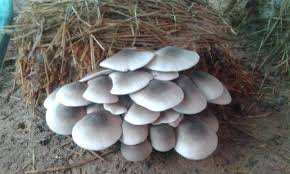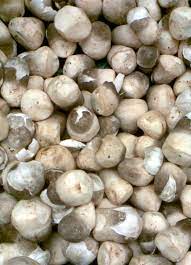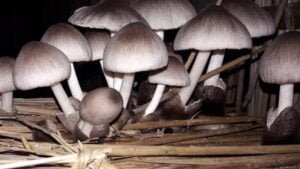Paddy Straw Mushroom Fruiting Conditions
Time to Colonize 7-10 days – time to fruit 1-2 weeks
Paddy straw mushrooms are a popular edible mushroom species grown for their delicate flavor and tender texture. Here are some of the ideal fruiting conditions for paddy straw mushrooms:
-
Temperature: Paddy straw mushrooms prefer temperatures between 75-85°F (24-29°C) for optimal growth and fruiting.
-
Humidity: High relative humidity (85-95%) is necessary to maintain moisture levels and prevent the fruiting bodies from drying out.
-
Light: Paddy straw mushrooms do not require direct sunlight, but do benefit from exposure to light. This helps to regulate the mushroom’s circadian rhythm and trigger fruiting.
-
Carbon Dioxide (CO2) levels: The ideal CO2 level for paddy straw mushroom cultivation is between 1000-1500 ppm.
-
Airflow: Good air circulation is important to prevent the buildup of harmful gases and to distribute fragments of the mushroom’s mycelium evenly.
-
Substrate: Paddy straw mushrooms are grown on a substrate of paddy straw that has been treated with a spawn of the mushroom’s mycelium.
By maintaining these conditions, these mushrooms can fruit and produce clusters of white to light-brown fruiting bodies with a delicate flavor and tender texture that are highly sought after by mushroom cultivators and gourmet chefs.
Buy A Paddy Straw Mushroom Grow Kit Today
Paddy Straw Mushroom Fruiting Temperature



 To ensure the prolific cultivation of Paddy Straw mushrooms, it’s imperative to foster an environment where the temperatures are precisely controlled, falling within the sweet spot of 25-30°C (77-86°F). This specific temperature range is more than a mere suggestion—it’s the lifeblood of the cultivation process, providing the necessary warmth that these mushrooms require to thrive. At these temperatures, the mycelium—the vegetative part of the mushroom—receives the optimal thermal encouragement to initiate and sustain the development of robust fruiting bodies.
To ensure the prolific cultivation of Paddy Straw mushrooms, it’s imperative to foster an environment where the temperatures are precisely controlled, falling within the sweet spot of 25-30°C (77-86°F). This specific temperature range is more than a mere suggestion—it’s the lifeblood of the cultivation process, providing the necessary warmth that these mushrooms require to thrive. At these temperatures, the mycelium—the vegetative part of the mushroom—receives the optimal thermal encouragement to initiate and sustain the development of robust fruiting bodies.
It’s this warmth that cues the mushrooms to transition from their vegetative growth phase to a reproductive one, where they begin to form the structures that will eventually become the mushrooms we harvest. The 25-30°C range is not arbitrary but is backed by the understanding of the mushroom’s natural growth patterns, often observed in their native climates.
Within this range, the metabolic activities within the mycelium are at their peak, enzymes are active, and the entire biological machinery of the mushroom works in concert to produce fruiting bodies with the right texture, size, and quality. Therefore, maintaining this temperature is not just crucial, it’s a meticulous balance that the cultivator must strike—too low, and the mushroom’s growth is stunted; too high, and the delicate processes that lead to fruiting are disrupted. This thermal balance is the cornerstone of the cultivation process, ensuring that the mushrooms can reach their full culinary potential, prized by chefs and food connoisseurs alike.
Paddy Straw Mushroom Fruiting Humidity
 Achieving a bountiful yield of Paddy Straw mushrooms hinges on creating an environment with a humidity range meticulously set around 80-85%. This level of moisture in the air is not merely beneficial but essential for the mushrooms to fruit successfully. It creates a microclimate that mirrors the natural conditions these mushrooms would encounter in the wild, which is essential for their lifecycle.
Achieving a bountiful yield of Paddy Straw mushrooms hinges on creating an environment with a humidity range meticulously set around 80-85%. This level of moisture in the air is not merely beneficial but essential for the mushrooms to fruit successfully. It creates a microclimate that mirrors the natural conditions these mushrooms would encounter in the wild, which is essential for their lifecycle.
The elevated humidity levels play a multifaceted role in the cultivation process. They help in maintaining the delicate balance of moisture that Paddy Straw mushrooms require, ensuring the fruiting bodies can develop without losing their supple texture to dry air. Moreover, this moisture-rich atmosphere is a deterrent to many common contaminants that could otherwise thrive and compete with the mushrooms, potentially spoiling the crop.
It is important to note that such high humidity must be carefully controlled. Without proper regulation, excess moisture can lead to the development of mold and bacteria, which would be detrimental to the mushrooms. Therefore, the cultivation space must be equipped to sustain these humidity levels consistently, without fluctuations that could stress the mushrooms or invite unwanted pathogens.
In practice, this often means employing specialized humidifiers or misting systems that can keep the air saturated with moisture, combined with hygrometers to monitor the levels closely. By keeping the humidity within this optimal range, cultivators can create the perfect conditions for Paddy Straw mushrooms to produce their best fruiting bodies, leading to a successful and clean harvest.
Check Out Our Paddy Straw Mushroom Spawn
Paddy Straw Mushroom Fruiting Co2

The Straw Loving mushroom, a delectable culinary delight, thrives when cultivated on its preferred substrate of rice straw. To shepherd these mushrooms through their fruiting phase, a delicate equilibrium of environmental conditions must be maintained, encompassing temperature, humidity, and carbon dioxide (CO2) levels.
CO2 concentrations play a pivotal role in the life cycle of these fungi. Levels that are too high can be detrimental, suppressing the growth and potentially leading to the demise of the mushrooms. Conversely, insufficient CO2 can adversely affect both the yield and the quality of the mushrooms, resulting in a less than optimal harvest.
For cultivators of Straw Loving mushrooms, striking the perfect balance of CO2 is crucial. An atmospheric CO2 concentration of approximately 2000-3000 parts per million (ppm) is the sweet spot for fruiting. This range encourages the mushrooms to develop fully, allowing them to achieve the size and flavor profile desired.
It’s important for mushroom farmers to monitor and adjust the CO2 levels in their growing environments actively. This often involves the use of CO2 sensors and ventilation systems to ensure that the gas concentrations remain within the ideal range for promoting healthy growth and maximizing the production of high-quality Straw Loving mushrooms.
Paddy Straw Mushroom Fruiting Fresh Air (FAE)
 Fresh air exchange (FAE) is indeed a crucial component in the fruiting process of Paddy Straw mushrooms, serving as a regulatory mechanism for various environmental factors within the cultivation space. The optimal rate of air exchange for these mushrooms is around 4-6 times per hour, a rhythm that helps to uphold the delicate balance necessary for their development.
Fresh air exchange (FAE) is indeed a crucial component in the fruiting process of Paddy Straw mushrooms, serving as a regulatory mechanism for various environmental factors within the cultivation space. The optimal rate of air exchange for these mushrooms is around 4-6 times per hour, a rhythm that helps to uphold the delicate balance necessary for their development.
By implementing this rate of FAE, cultivators can effectively manage CO2 concentrations, ensuring they remain at levels conducive to mushroom growth—neither too high to stunt development nor too low to impair yield. It’s this controlled exchange of air that also assists in moderating humidity levels, eliminating surplus moisture that could potentially lead to the proliferation of contaminants.
Moreover, a consistent FAE rate is instrumental in fostering an environment that mirrors the natural airflow mushrooms would experience in the wild. This not only aids in maintaining an optimal climate but also stimulates the Paddy Straw mushrooms to produce fruiting bodies that are robust and healthy. A proper air exchange system, therefore, is key to both preventing the advent of pathogens and encouraging the full and vigorous growth of the mushrooms, leading to a successful and sanitary harvest.
We Have Only The Best Paddy Straw Mushroom Liquid Culture Available
The cultivation of Paddy Straw mushrooms, or Volvariella volvacea, is an engaging and rewarding endeavor, often utilizing rice straw or similar agricultural waste as a substrate. These mushrooms are well-suited to the warm and moist conditions prevalent in tropical and subtropical climates, where they can flourish abundantly.
One of the remarkable attributes of Paddy Straw mushrooms is their swift growth cycle, allowing for a quicker turnaround from planting to harvest compared to many other mushroom varieties. This, coupled with their relatively straightforward maintenance, makes them an appealing option for both novice home growers and seasoned commercial farmers. Their ability to thrive in a variety of settings and the minimal requirement for specialized equipment or intensive labor further enhances their popularity among those interested in mushroom cultivation. Whether for personal consumption or as a commercial venture, cultivating Paddy Straw mushrooms offers a gratifying experience and a delicious end product.
Paddy Straw mushrooms, far more than just a culinary delight, also boast a spectrum of health benefits, making them a nutritious addition to any diet. They are rich in essential proteins, providing the building blocks necessary for body repair and maintenance. Additionally, they are a source of various vitamins and minerals, contributing to overall health and well-being.
Emerging research suggests that these mushrooms may carry medicinal properties, potentially offering antioxidant, anti-inflammatory, and even immune-boosting effects. This aspect of Paddy Straw mushrooms is an exciting area of study, pointing to a future where they might not only be savored for their taste but also valued for their contribution to health and medicine.
For those intrigued by the culinary arts or the science of mycology, Paddy Straw mushrooms present a fascinating subject. They offer a gateway into the diverse and intricate world of fungi, promising both a pleasurable eating experience and a rewarding cultivation journey. Whether you’re a gourmet seeking new ingredients to master or a hobbyist looking to delve into the art of mushroom growing, Paddy Straw mushrooms provide a versatile and enriching avenue to explore.
Concluding Thoughts on Cultivating and Enjoying Paddy Straw Mushrooms
As we conclude our exploration of Paddy Straw mushrooms, or Volvariella volvacea, it’s clear that these fungi are not just a culinary treasure but also a fascinating subject for cultivation and health studies. From their optimal fruiting conditions requiring a delicate balance of temperature, humidity, CO2, and light, to their rapid growth cycle and the simplicity of their cultivation, these mushrooms offer a rewarding experience for both commercial cultivators and home enthusiasts. They thrive under a specific range of environmental conditions, from the warmth of 25-30°C (77-86°F) to the high humidity of 80-85%, with proper air exchange and lighting to stimulate and sustain fruiting.
Beyond their rich, subtly earthy flavor and tender texture that make them a staple in Asian cuisine, Paddy Straw mushrooms hold potential health benefits, being rich in proteins, vitamins, and minerals, with emerging research suggesting possible medicinal properties. This makes them not only a delight to the palate but also a beneficial addition to a nutritious diet.
Whether your interest lies in the culinary arts, the science of mycology, or simply the joy of growing your own food, Paddy Straw mushrooms present a versatile and enriching avenue to explore. They are a testament to the wonders of fungi, offering a window into the complexity of nature and the satisfaction of harvesting your own delicious and nutritious mushrooms. So, whether you’re a seasoned grower or a curious newcomer, consider embarking on the rewarding journey of cultivating Paddy Straw mushrooms.
Try Our Paddy Straw Mushroom Ready to Fruit Blocks Now!
Paddy Straw Mushroom Fruiting Lighting
The cultivation of Paddy Straw mushrooms, scientifically referred to as Volvariella volvacea, is a nuanced art that extends to the regulation of light exposure during their fruiting phase. These mushrooms necessitate a specific lighting regimen to trigger and sustain the fruiting process. A transition from darkness into light serves as a signal for the mushrooms to commence fruiting, with a recommended light-dark cycle lasting 12 hours each to simulate the natural day-night rhythm.
During the light cycle, a gentle intensity of approximately 30-50 lux is optimal. This level of illumination is mild yet sufficient to catalyze the fruiting process without causing any detrimental effects on the mushrooms. Whether the light source is the sun’s natural rays diffused into the growing area or an artificial setup designed to mimic daylight, the key is consistency and the avoidance of any flickering which could induce stress within the mushroom crop.
Moreover, the importance of a clean fruiting environment cannot be overstated. It is essential to maintain cleanliness and order within the growing area, ensuring that any debris or obstruction is cleared away. Such diligence ensures that the light can permeate the space effectively, reaching the mushrooms and facilitating a healthy and robust growth. By adhering to these light conditions and maintaining a tidy cultivation space, Paddy Straw mushrooms can flourish, yielding a bountiful and high-quality harvest.
We Have Only The Best Paddy Straw Mushroom Liquid Culture Available
The cultivation of Paddy Straw mushrooms, or Volvariella volvacea, is an engaging and rewarding endeavor, often utilizing rice straw or similar agricultural waste as a substrate. These mushrooms are well-suited to the warm and moist conditions prevalent in tropical and subtropical climates, where they can flourish abundantly.
One of the remarkable attributes of Paddy Straw mushrooms is their swift growth cycle, allowing for a quicker turnaround from planting to harvest compared to many other mushroom varieties. This, coupled with their relatively straightforward maintenance, makes them an appealing option for both novice home growers and seasoned commercial farmers. Their ability to thrive in a variety of settings and the minimal requirement for specialized equipment or intensive labor further enhances their popularity among those interested in mushroom cultivation. Whether for personal consumption or as a commercial venture, cultivating Paddy Straw mushrooms offers a gratifying experience and a delicious end product.
Paddy Straw mushrooms, far more than just a culinary delight, also boast a spectrum of health benefits, making them a nutritious addition to any diet. They are rich in essential proteins, providing the building blocks necessary for body repair and maintenance. Additionally, they are a source of various vitamins and minerals, contributing to overall health and well-being.
Emerging research suggests that these mushrooms may carry medicinal properties, potentially offering antioxidant, anti-inflammatory, and even immune-boosting effects. This aspect of Paddy Straw mushrooms is an exciting area of study, pointing to a future where they might not only be savored for their taste but also valued for their contribution to health and medicine.
For those intrigued by the culinary arts or the science of mycology, Paddy Straw mushrooms present a fascinating subject. They offer a gateway into the diverse and intricate world of fungi, promising both a pleasurable eating experience and a rewarding cultivation journey. Whether you’re a gourmet seeking new ingredients to master or a hobbyist looking to delve into the art of mushroom growing, Paddy Straw mushrooms provide a versatile and enriching avenue to explore.
Concluding Thoughts on Cultivating and Enjoying Paddy Straw Mushrooms
As we conclude our exploration of Paddy Straw mushrooms, or Volvariella volvacea, it’s clear that these fungi are not just a culinary treasure but also a fascinating subject for cultivation and health studies. From their optimal fruiting conditions requiring a delicate balance of temperature, humidity, CO2, and light, to their rapid growth cycle and the simplicity of their cultivation, these mushrooms offer a rewarding experience for both commercial cultivators and home enthusiasts. They thrive under a specific range of environmental conditions, from the warmth of 25-30°C (77-86°F) to the high humidity of 80-85%, with proper air exchange and lighting to stimulate and sustain fruiting.
Beyond their rich, subtly earthy flavor and tender texture that make them a staple in Asian cuisine, Paddy Straw mushrooms hold potential health benefits, being rich in proteins, vitamins, and minerals, with emerging research suggesting possible medicinal properties. This makes them not only a delight to the palate but also a beneficial addition to a nutritious diet.
Whether your interest lies in the culinary arts, the science of mycology, or simply the joy of growing your own food, Paddy Straw mushrooms present a versatile and enriching avenue to explore. They are a testament to the wonders of fungi, offering a window into the complexity of nature and the satisfaction of harvesting your own delicious and nutritious mushrooms. So, whether you’re a seasoned grower or a curious newcomer, consider embarking on the rewarding journey of cultivating Paddy Straw mushrooms.
